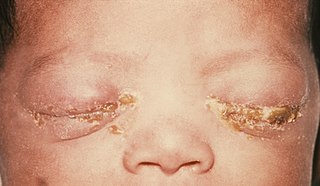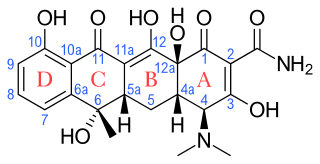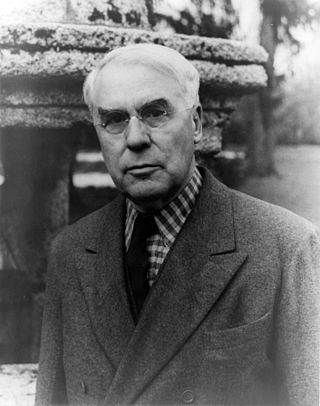Related Research Articles

Penicillins are a group of β-lactam antibiotics originally obtained from Penicillium moulds, principally P. chrysogenum and P. rubens. Most penicillins in clinical use are synthesised by P. chrysogenum using deep tank fermentation and then purified. A number of natural penicillins have been discovered, but only two purified compounds are in clinical use: penicillin G and penicillin V. Penicillins were among the first medications to be effective against many bacterial infections caused by staphylococci and streptococci. They are still widely used today for different bacterial infections, though many types of bacteria have developed resistance following extensive use.
In molecular biology and pharmacology, a small molecule or micromolecule is a low molecular weight organic compound that may regulate a biological process, with a size on the order of 1 nm. Many drugs are small molecules; the terms are equivalent in the literature. Larger structures such as nucleic acids and proteins, and many polysaccharides are not small molecules, although their constituent monomers are often considered small molecules. Small molecules may be used as research tools to probe biological function as well as leads in the development of new therapeutic agents. Some can inhibit a specific function of a protein or disrupt protein–protein interactions.

A disinfectant is a chemical substance or compound used to inactivate or destroy microorganisms on inert surfaces. Disinfection does not necessarily kill all microorganisms, especially resistant bacterial spores; it is less effective than sterilization, which is an extreme physical or chemical process that kills all types of life. Disinfectants are generally distinguished from other antimicrobial agents such as antibiotics, which destroy microorganisms within the body, and antiseptics, which destroy microorganisms on living tissue. Disinfectants are also different from biocides—the latter are intended to destroy all forms of life, not just microorganisms. Disinfectants work by destroying the cell wall of microbes or interfering with their metabolism. It is also a form of decontamination, and can be defined as the process whereby physical or chemical methods are used to reduce the amount of pathogenic microorganisms on a surface.

In the fields of medicine, biotechnology and pharmacology, drug discovery is the process by which new candidate medications are discovered.

Coomassie brilliant blue is the name of two similar triphenylmethane dyes that were developed for use in the textile industry but are now commonly used for staining proteins in analytical biochemistry. Coomassie brilliant blue G-250 differs from Coomassie brilliant blue R-250 by the addition of two methyl groups. The name "Coomassie" is a registered trademark of Imperial Chemical Industries.

Medicinal or pharmaceutical chemistry is a scientific discipline at the intersection of chemistry and pharmacy involved with designing and developing pharmaceutical drugs. Medicinal chemistry involves the identification, synthesis and development of new chemical entities suitable for therapeutic use. It also includes the study of existing drugs, their biological properties, and their quantitative structure-activity relationships (QSAR).
An antimicrobial is an agent that kills microorganisms (microbicide) or stops their growth. Antimicrobial medicines can be grouped according to the microorganisms they act primarily against. For example, antibiotics are used against bacteria, and antifungals are used against fungi. They can also be classified according to their function. The use of antimicrobial medicines to treat infection is known as antimicrobial chemotherapy, while the use of antimicrobial medicines to prevent infection is known as antimicrobial prophylaxis.

Povidone-iodine (PVP-I), also known as iodopovidone, is an antiseptic used for skin disinfection before and after surgery. It may be used both to disinfect the hands of healthcare providers and the skin of the person they are caring for. It may also be used for minor wounds. It may be applied to the skin as a liquid or a powder.

The oligodynamic effect is a biocidal effect of metals, especially heavy metals, that occurs even in low concentrations.

Prontosil is an antibacterial drug of the sulfonamide group. It has a relatively broad effect against gram-positive cocci but not against enterobacteria. One of the earliest antimicrobial drugs, it was widely used in the mid-20th century but is little used today because better options now exist. The discovery and development of this first sulfonamide drug opened a new era in medicine, because it greatly widened the success of antimicrobial chemotherapy in an era when many physicians doubted its still largely untapped potential. At the time, disinfectant cleaners and topical antiseptic wound care were widely used but there were very few antimicrobial drugs to use safely inside living bodies. Antibiotic drugs derived from microbes, which we rely on heavily today, did not yet exist. Prontosil was discovered in 1932 by a research team at the Bayer Laboratories of the IG Farben conglomerate in Germany.

Neonatal conjunctivitis is a form of conjunctivitis which affects newborn babies following birth. It is typically due to neonatal bacterial infection, although it can also be non-infectious. Infectious neonatal conjunctivitis is typically contracted during vaginal delivery from exposure to bacteria from the birth canal, most commonly Neisseria gonorrhoeae or Chlamydia trachomatis.

Tetracyclines are a group of broad-spectrum antibiotic compounds that have a common basic structure and are either isolated directly from several species of Streptomyces bacteria or produced semi-synthetically from those isolated compounds. Tetracycline molecules comprise a linear fused tetracyclic nucleus to which a variety of functional groups are attached. Tetracyclines are named after their four ("tetra-") hydrocarbon rings ("-cycl-") derivation ("-ine"). They are defined as a subclass of polyketides, having an octahydrotetracene-2-carboxamide skeleton and are known as derivatives of polycyclic naphthacene carboxamide. While all tetracyclines have a common structure, they differ from each other by the presence of chloro, methyl, and hydroxyl groups. These modifications do not change their broad antibacterial activity, but do affect pharmacological properties such as half-life and binding to proteins in serum.

Albert Coombs Barnes was an American chemist, businessman, art collector, writer, and educator, and the founder of the Barnes Foundation in Philadelphia, Pennsylvania.

Bleach is the generic name for any chemical product that is used industrially or domestically to remove colour (whitening) from fabric or fiber or to disinfect after cleaning. It often refers specifically to a dilute solution of sodium hypochlorite, also called "liquid bleach".
Aspirin is a novel organic compound that does not occur in nature, and was first successfully synthesised in 1899. In 1897, scientists at the drug and dye firm Bayer began investigating acetylated organic compounds as possible new medicines, following the success of acetanilide ten years earlier. By 1899, Bayer created acetylsalicylic acid and named the drug 'Aspirin', going on to sell it around the world. The word Aspirin was Bayer's brand name, rather than the generic name of the drug; however, Bayer's rights to the trademark were lost or sold in many countries. Aspirin's popularity grew over the first half of the twentieth century, leading to fierce competition with the proliferation of aspirin brands and products.
Debiopharm is a privately-held Swiss biopharmaceutical company mainly active in development and clinical testing of drug candidates. It was founded in 1979 by Rolland-Yves Mauvernay.
Zonite Products Corporation was a New York City based company formed in 1922. Headquartered in the Chrysler Building, it became a leader in the medical preparations' field starting in 1930. In February 1930, it purchased for $215,000 the New Brunswick manufacturing plant of Reichardt Cocoa & Chocolate Company. By April 1931, Zonite's subsidiaries became concentrated in a single production facility. These included Zonite, Forhan's toothpaste and antiseptic, Argyrol, and Larvex. Annette's Perfect Cleanser Company was acquired in March 1932.
Drug nomenclature is the systematic naming of drugs, especially pharmaceutical drugs. In the majority of circumstances, drugs have 3 types of names: chemical names, the most important of which is the IUPAC name; generic or nonproprietary names, the most important of which are international nonproprietary names (INNs); and trade names, which are brand names. Under the INN system, generic names for drugs are constructed out of affixes and stems that classify the drugs into useful categories while keeping related names distinguishable. A marketed drug might also have a company code or compound code.

Chlorine-releasing compounds, also known as chlorine base compounds, is jargon to describe certain chlorine-containing substances that are used as disinfectants and bleaches. They include the following chemicals: sodium hypochlorite, chloramine, halazone, and sodium dichloroisocyanurate. They are widely used to disinfect water and medical equipment, and surface areas as well as bleaching materials such as cloth. The presence of organic matter can make them less effective as disinfectants. They come as a liquid solution, or as a powder that is mixed with water before use.
Mark L. Nelson is an American chemist specializing in the field of antibiotics and tetracyclines. His synthesis techniques have resulted in over 40 patents and he conceived and synthesized with Mohamed Ismail along with Laura Honeyman, the tetracycline antibiotic Omadacycline (Nuzyra), the first of the Aminomethylcycline subclass of tetracyclines to reach medical use. Nuzyra is useful against resistant bacteria and used for severe cases of skin infections, ABSSSIs, Community Acquired Pneumonia (CABP) and nontuberculosis mycobacteria. Nuzyra also has demonstrated activity against Anthrax, and was purchased by the US government under a BARDA contract for Project Bio-shield to treat anthrax exposure, and is now in the Strategic National Stockpile in the US in case of a bioterrorism attack. Nuzyra was also approved for use against the Plague, caused by Yersinia pestis infections.
References
- ↑ "The Ogre of Merion". Time magazine. June 27, 1960. Archived from the original on October 8, 2010. Retrieved March 19, 2010.
He and a brilliant young German student, Hermann Hille, worked out the formula for Argyrol, a mild silver protein solution for which doctors had many uses—to treat gonorrhoea, including gonorrheal blindness, relieve severe nasal congestion.... In 1928, with superb timing, Barnes sold out Argyrol for an estimated $4,000,000.
- ↑ "Trade-Marks Labels Issue of November 18th". Druggists' While Employed with Mulford & Co. (Which Later Became Merck & Co.), American Physician Dr. Albert Coombs Barnes Recruited German Chemist Dr. Hermann Hille. Together, They Returned to the United States and Left Mulford & Co. To Launch Argyrol. Circular and Chemical Gazette (1866-1906). 47 (1): 22. 1 January 1903.
- ↑ "Medical Progress: Eye, Ear, Nose and Throat". Medical News. 82 (4): 172. 24 January 1903.
- ↑ Schack, William (1963) [copyright 1960, Sagamore Press]. Art and Argyrol (Revised ed.). New York City: A. S. Barnes and Company. pp. 48, 49, 54. The original company was a partnership of Dr. Albert C. Barnes, a physician, and Dr. Herman Hille, a chemist, who developed the process of manufacturing it at the urging of Barnes.
- 1 2 Edouard, Lindsay (September 2011). "Antisepsis with Argyrol, Acrimony and Advocacy for African Art". African Journal of Reproductive Health. 15 (3): 9–14. PMID 22574488 . Retrieved 28 November 2018.
- ↑ "The Art of Stealing from the Rich and Dead". Vanity Fair. March 2, 2010. Retrieved March 12, 2010.
- ↑ Arthur Williams (December 1, 2000). "Alfred Barnes, Argyrol and Art". Pharmaceutical Journal. London and Chicago: Pharmaceutical Press. 265 No 7128 (December 23/30, 2000 Christmas miscellany): 933–934. Archived from the original on April 20, 2009.
- ↑ Broad Street Gossip, The Wall Street Journal , August 17, 1929, p. 2.
- ↑ Schack, William (1963) [1960]. Art and Argyrol (Revised ed.). New York City: A. S. Barnes and Company. pp. 47–49. This description is based on information given to the author by Dr. Hermann Hille, the original chemist partner of Dr. Albert Barnes in the Barnes and Hille, Chemists company that first sold Argyrol in 1902 from a plant at 24 North 40th St., Philadelphia, Pennsylvania.